How to Write an Effective Blog Description (with Examples)
 Tamal Chowdhury
Tamal Chowdhury
Today I am going to show you how you can write an effective blog description that will help you describe your blog to the users and search engines like Google and Bing.
How to write an effective blog description:
- Include your blog name and author-name
- Add your blog topic/primary keyword
- Add credentials to stand out
- Use psychological power words
- Keep the description within 150-155 characters
- Use Yoast SEO WordPress plugin to optimize it
Here’s a template of a blog description that can get you started writing one:
[blog name] is a blog that helps [target audience] do/achieve [desired benefit].
This kind of optimization also helped my blog posts to stand out and get higher click through rates both from Google and from Facebook social share.
In this post, I will show you how you can write a good blog description, what are some of the examples of other top blogs and finally give you a step-by-step overview of how you can setup descriptions for your own WordPress blog.
What is a blog description?
A blog description is a short summary of what your blog is about. In the context of SEO, we are talking about the meta description which shows up in search listings and social media shares.
By the way, this is the meta tag. A Meta description tag is a special HTML meta tag that tells a computer, such as Google what the entire page is about. Here’s how it looks in code:

If you think about it, a description is just like a summary of your blog. Since you have picked a central topic for your blog, you should have a one-liner tagline for your site. This tagline can be used on top of your blog just like I have set my tagline in my blog.
An SEO meta description has the option to go beyond one line and allows you to further explain the topic, who is it for and what are the sub-topics you are going to cover.
The blog description is independent of your blog content and is actually part of the meta-information. When you write a description, it will not appear anywhere in your blog but it always derives from the source content.
We have a description for the main blog, yourblog.com which is the most important meta-information we can have for the site.
Every other blog articles act as an individual entity in the eyes of Google so each of the blog articles and pages can also have their unique blog description.
Now there is no harm in not having a custom blog description but when you have one, you get to improve your chances for success.
Why is it important to have a custom blog description?
With a custom blog description, you can say exactly what your page is about and stand out from other websites. This can help you get more clicks and better search rankings.
When we are building a blog website, our primary promotion happens using Google search. Every time someone searches about a solution, Google will show hundreds of webpages to the user. The internet searcher doesn’t want to check out each and every page, she just wants to pick the one page that correctly answers her query.
When five other pages are offering the same answer, then the searcher will either pick the first one or the one that has the most compelling description.
Just have a look at this article.
You have searched for this topic on Google and you may have come across a search listing like this.
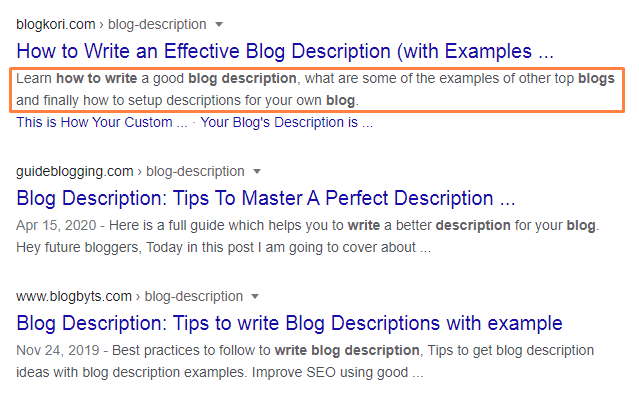
You picked my page instead of my competitors just because my description resonates the most with your problem area.
Setting up a custom description for your blog falls into the copywriting area that can improve your traffic with existing positions.
Now, you have to consider one thing. Is it really worth the effort to set a custom description for each and every blog post you have?
Is the time spent optimizing the blog description worth it?
If you have a couple of winning blog posts bringing you steady traffic, then it’s well worth the time to change the meta descriptions and measure the results. However, if you have 30-50 or even a hundred blog posts, then I don’t think you should bother about it.
You will get more impact on updating the content rather than just optimizing the blog description.
That being said, your time is better spent when you do it for writing new content. In the BlogKori philosophy, we spend 80% of our time writing fresh content and the other 20% updating and optimizing the old content. If the time you will spend for setting custom blog description falls into the 20%, then go ahead and change them.
However, you may find that setting a custom blog description is not very effective nowadays.
Google picks your own blog description
On many occasions, Google will pick the most appropriate snippet of text from the blog article and display the Google search result page. This is because most people don’t use the exact search phrase to find your blog; oftentimes they come up to your blog using an alternative yet relevant search phrase.
Take a look at this very blog post on Google search.
I assume people would search for how to write a blog description and this is how it should appear.
Search term: blog description examples

But in reality, people search for various things and Google will pick a generated blog description in place of the meta description.
Search term: lifestyle blog description examples

Bottom line: A custom meta description is good but may not be useful in all the practical use cases.
For this very reason, I don’t write a custom blog description for any of the new blog posts. I wait until the pages have been ranked somewhere before optimizing.
This is How Your Custom Blog Description Looks Like in Google Search
You must have come to this post by making a Google search, so you probably know how search listings look like. What you may not know is, you can control the title and description for your own site. Take a look at this description of A Cup of Jo, one of the top lifestyle blogs:

Cup of Jo is a daily women’s lifestyle site founded by Joanna Goddard that covers style, design, culture, food, travel, relationships, and parenting.
This is good because:
- You are telling the potential visitor what exactly your blog is about
- You get to entice the searcher to click on the search result
- With more clicks, you get to gain higher search rankings
But when someone does not provide a custom blog description, Google will be in charge to pick one for you because it does not want to leave the description field blank.
Here is another example from yet another popular lifestyle blog that does not have a custom blog description:

Image hint to my secret project | Amber Fillerup Clark | Barefoot Blonde. 0 Likes | like the post +. This month I will be announcing something really exciting that I …
In this example, Google couldn’t find an appropriate Meta description tag, so it picked the first few sentences and words it could find containing the search term (Barefoot Blonde).
Why is this bad?
- Searchers don’t have a clue what this blog is about, so they will click less
- With fewer clicks, Google will put this listing down in the search results
- You are leaving valuable traffic (and money) on the table by not taking advantage of your search listing
So now that you know how a blog description looks like in Google and why leaving it empty is a bad idea, let me show you a few more examples from some of the other top blogs. This will surely give you some inspiration to write your own.
Blog Description Examples
Here are some of the blog description examples from some of the top blogs.
Lifestyle Blog Description Examples
Here are the blog descriptions from some of the top lifestyle blogs:







Travel blog description examples
Here go the descriptions from some of the top travel blogs:







Now let’s discuss how we can write a good blog description below.
Tips to Write an Effective Blog Description
The best way to come up with a good description of your blog is to think of it as an elevator pitch. An elevator pitch is your business explained in 2-3 lines. The name comes from the idea that if you can pitch your business when you are inside an elevator.
After looking at the top blog description examples, you must have had an idea of how they are worded together. Use this format to get started:
[blog name] is a blog that helps [target audience] do/achieve [desired benefit]
Although I am not a copy-writer, here are some of the tips I can give you based on the well-written descriptions we looked so far:
Include your blog name and author name in the description
Often times popular blogs are run by one person which makes the author famous. Include your name in the description for when someone searches for your name to find your blog. Adding your name also shows the human side of the blog.


Add your main blog topic and keywords
Have your main blog topics, like the main categories in the description which will help people find your blog even if they don’t know the name of it. You should also have the primary keywords somewhere in your blog description.


Add your credentials to stand out
One good way to stand out from other blog listings in Google search is to offer your credentials in the blog description. Mention any award or achievements that show that you know what you are talking about.



Use psychological power words
Writing a good blog description falls into copywriting and there are a few hacks that can help you come up with a strong copy. You can make use of the power words to compose a meta description.
Start your description by engaging them:
- Learn how to…
- Let’s see what…
- What happens when…
Use power words that move the reader emotionally like:
- killer
- effective
- bulletproof
- free
- outperform
End the description with a call to action:
- Click here
- Read the case study
- Learn more
- View the report
Here is a list of strong power words you can use.
Keep it within 150-155 characters long
The final tip I want to give you is to keep your blog description within 150-155 characters. Google doesn’t have any concrete limit now because these days depending on the type of result, the amount of text can go way higher. But a general rule for blogs is to keep within this character length.
When you are going to sit down and write your blog description, you may not have a clue for how many letters you have typed, so you can always check the character count using this online tool.

Now that you know how to write killer blog descriptions, let’s have a look at how we can actually set it up for your WordPress blog.
How to set your custom blog description in WordPress?
You have written a good description for your blog, now it’s time for you to plug it into your website code. Fortunately, for WordPress bloggers, it’s very easy to do it without even having to touch a single line of code.
If you don’t have a blog on WordPress yet, you are missing out on an excellent opportunity. Click here to read how you can start a blog with WP.
The best way to set a custom blog meta description is by using a popular WordPress plugin called Yoast SEO. Install and activate Yoast SEO and head over to SEO > Search Appearance in your site backend:
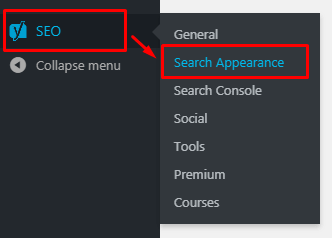
Now enter your awesome new blog description under the Meta description textbox and click save changes.
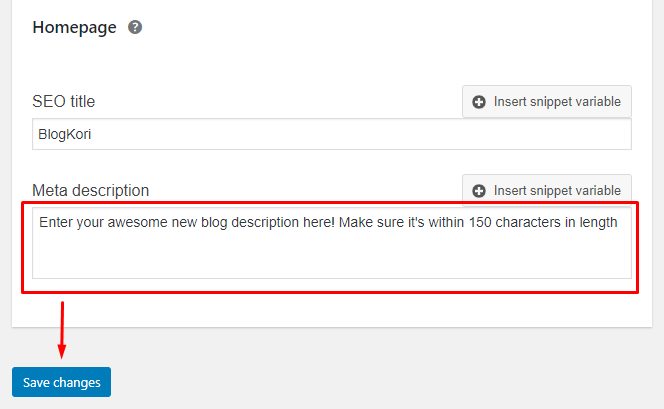
This option sets the blog description for your entire blog for when someone searches for the blog name in Google search. Like the ones you saw earlier in the blog description examples:

To set the description for individual posts and pages, you will have to edit that particular post. Let’s say I am updating an older post from my blog. I will go to Posts > All Posts, highlight the post and click on edit:
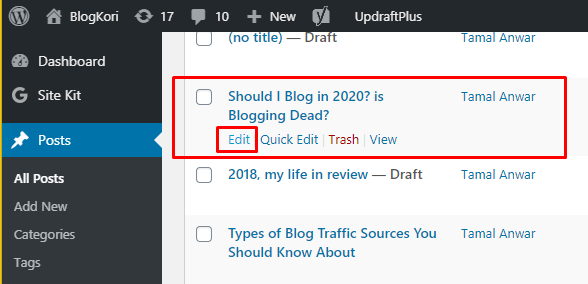
Now on the next screen, scroll down to find the Yoast SEO section and click on the arrow to reveal Yoast SEO options:
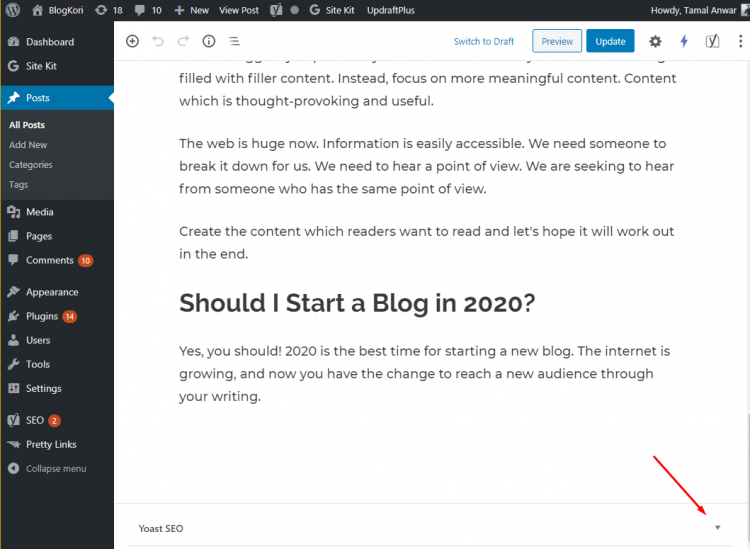
Now you will see a preview of your blog post in Google search. Click on Edit snippet to reveal the snippet editor:
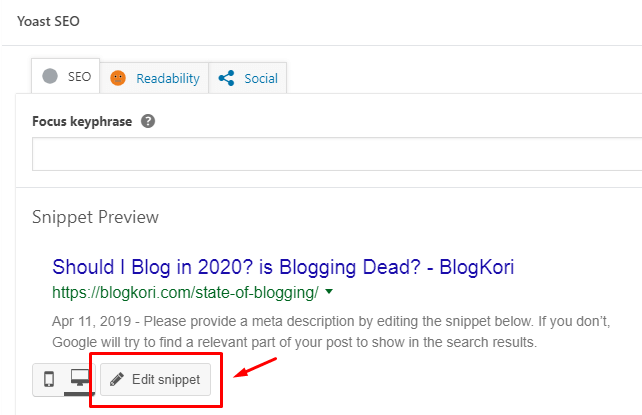
Type in your custom description in the Meta description textbox.
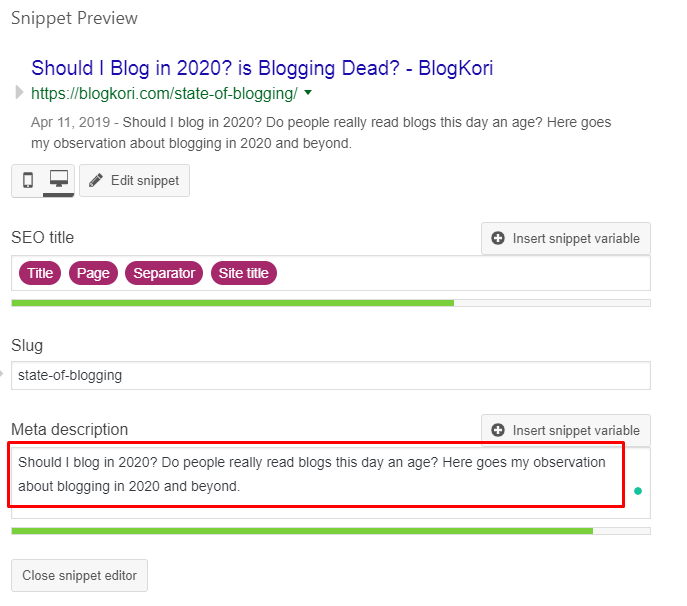
As you type in, you will see the preview on top of the Snippet Preview area, also an orange bar underneath the text box.
Once you have written enough text of a certain length (ideally around 150 letters) you will see the bar turning green, which means you are good to go.
You are allowed to go overboard and write more, but as you will notice, a very long blog description will just cut off from the snippet preview which is just a waste of effort.
Once you are happy with your custom blog description, click update on top of the page to save your changes.
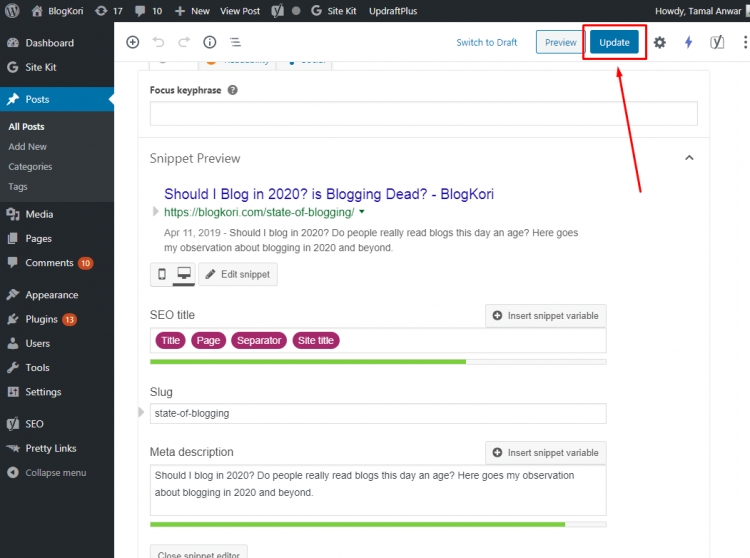
Do the same for all of your important blog posts.
How long it takes for my meta description to show up on Google?
It will take a few days for your custom meta description to show up on Google. Sometimes it will show up instantly. More on it later this post.
Next Steps
Now that you know how to write a good blog description and implement it in your blog, go ahead and start writing one.
- Start writing your blog description
- If you need to start fresh, you can start a blog here
- Let me know in the comments how are you going to implement these tips
[](https://www.addtoany.com/add_to/facebook?linkurl=https%3A%2F%2Fblogkori.com%2Fblog-description&linkname=How%20to%20Write%20an%20Effective%20Blog%20Description%20%28with%20Examples%29 "Facebook")[](https://www.addtoany.com/add_to/facebook_messenger?linkurl=https%3A%2F%2Fblogkori.com%2Fblog-description&linkname=How%20to%20Write%20an%20Effective%20Blog%20Description%20%28with%20Examples%29 "Facebook Messenger")[](https://www.addtoany.com/add_to/twitter?linkurl=https%3A%2F%2Fblogkori.com%2Fblog-description&linkname=How%20to%20Write%20an%20Effective%20Blog%20Description%20%28with%20Examples%29 "Twitter")[](https://www.addtoany.com/add_to/linkedin?linkurl=https%3A%2F%2Fblogkori.com%2Fblog-description&linkname=How%20to%20Write%20an%20Effective%20Blog%20Description%20%28with%20Examples%29 "LinkedIn")[](https://www.addtoany.com/add_to/email?linkurl=https%3A%2F%2Fblogkori.com%2Fblog-description&linkname=How%20to%20Write%20an%20Effective%20Blog%20Description%20%28with%20Examples%29 "Email")
The post How to Write an Effective Blog Description (with Examples) appeared first on BlogKori.
Subscribe to my newsletter
Read articles from Tamal Chowdhury directly inside your inbox. Subscribe to the newsletter, and don't miss out.
Written by

Tamal Chowdhury
Tamal Chowdhury
Learning and Building in public with React, JavaScript, NodeJS, Chrome Extensions, Android, Kotlin. I write, create & teach. Let's connect!